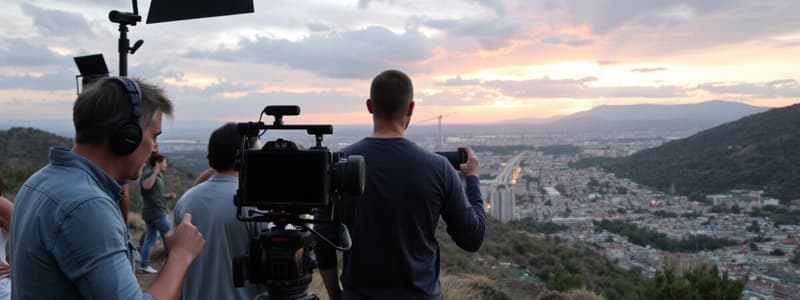Podcast
Questions and Answers
What is a primary objective of script breakdown in pre-production planning?
What is a primary objective of script breakdown in pre-production planning?
- To identify locations and needed props (correct)
- To schedule crew meetings
- To categorize filming equipment
- To develop character backstories
Which technique is NOT typically used during location scouting?
Which technique is NOT typically used during location scouting?
- Site visits for assessment
- Developing character arcs (correct)
- Photographic documentation
- Conducting online research
What is a key component of risk management in filming?
What is a key component of risk management in filming?
- Creating shot lists
- Engaging with local businesses
- Identifying potential hazards (correct)
- Budgeting for location permits
Which budget item is NOT relevant when budgeting for filming locations?
Which budget item is NOT relevant when budgeting for filming locations?
During technical scouting, which aspect is primarily assessed?
During technical scouting, which aspect is primarily assessed?
What should be included in contingency planning?
What should be included in contingency planning?
What is one of the first steps in pre-production planning?
What is one of the first steps in pre-production planning?
Which factor is crucial when assessing a location's suitability during site visits?
Which factor is crucial when assessing a location's suitability during site visits?
In terms of insurance, what is the primary concern for a film production?
In terms of insurance, what is the primary concern for a film production?
When budgeting for locations, what unexpected costs should be included?
When budgeting for locations, what unexpected costs should be included?
Study Notes
Film Production Scheduling and Location Management
Pre-production Planning
- Involves organizing all aspects of a film before shooting begins.
- Key components:
- Script Breakdown: Analyze the script to identify locations, characters, and props needed.
- Shooting Schedule: Create a timeline that outlines when and where each scene will be filmed.
- Resource Allocation: Assign roles and responsibilities to crew members.
- Permits and Legalities: Secure necessary permissions and clearances for filming locations.
Location Scouting Techniques
- Research: Use online databases and local resources to identify potential filming locations.
- Site Visits: Physically visit locations to assess their suitability, including lighting, accessibility, and aesthetics.
- Photographic Documentation: Take photos for reference and decision-making later.
- Community Engagement: Connect with locals and businesses for insights and potential support.
Risk Management In Filming
- Identify Risks: Analyze potential hazards related to locations (e.g., weather, safety concerns).
- Contingency Planning: Develop alternative plans to address unforeseen issues, such as delays or location changes.
- Insurance: Obtain the necessary insurance coverage for equipment and liability.
- Health and Safety Protocols: Implement guidelines to ensure the safety of crew and cast during shoots.
Budgeting For Locations
- Location Fees: Account for costs associated with renting or using a location.
- Logistics: Include transportation, accommodation, and catering costs for the crew on location.
- Permits and Licenses: Budget for governmental fees required to film in certain areas.
- Contingency Fund: Allocate extra funds for unexpected expenses related to locations.
Technical Scouting
- Equipment Assessment: Evaluate the location for technical requirements like power sources and connectivity for cameras and lighting.
- Sound Considerations: Analyze ambient noise levels and acoustics that could affect audio recording.
- Lighting Conditions: Assess natural light availability and plan additional lighting needs.
- Crew Accessibility: Check if the location can accommodate all crew members and equipment during filming.
Pre-production Planning
- Organizing all aspects of a film prior to the start of shooting is essential for efficiency.
- Script Breakdown involves analyzing the screenplay to determine required locations, characters, and props.
- A Shooting Schedule outlines the specific timeline for filming each scene, including locations and times.
- Resource Allocation assigns specific roles and responsibilities to crew members to ensure a smooth production.
- Permits and Legalities necessitate securing permissions and clearances for designated filming sites.
Location Scouting Techniques
- Research employs online databases and local resources to find suitable filming locations.
- Site Visits are crucial for assessing locations in terms of lighting, accessibility, and visual appeal.
- Photographic Documentation is necessary for capturing images of potential locations for future reference and decision-making.
- Community Engagement builds relationships with local residents and businesses for insights and potential assistance.
Risk Management in Filming
- Identify Risks such as weather-related hazards and safety concerns associated with filming locations.
- Contingency Planning involves creating alternative plans to tackle unforeseen issues like delays or location changes.
- Insurance is required to cover equipment damages and liability for potential accidents during filming.
- Health and Safety Protocols must be established to safeguard crew and cast during filming.
Budgeting for Locations
- Location Fees account for costs incurred when renting or utilizing a filming site.
- Logistics includes financial considerations for transporting the crew, providing accommodation, and catering on location.
- Permits and Licenses budget for necessary governmental fees that allow filming in specific areas.
- A Contingency Fund should be set aside for unexpected expenses tied to filming locations.
Technical Scouting
- Equipment Assessment determines the technical infrastructure needed, including power supplies for cameras and lighting.
- Sound Considerations focus on evaluating ambient noise levels and acoustics that could interfere with audio recordings.
- Lighting Conditions are assessed for natural light availability, factoring in the need for additional artificial lighting.
- Crew Accessibility ensures that the location can accommodate all crew members and equipment during the filming process.
Studying That Suits You
Use AI to generate personalized quizzes and flashcards to suit your learning preferences.
Description
Explore the crucial steps involved in pre-production planning for film. This quiz covers script breakdown, shooting schedules, resource allocation, and location scouting techniques. Test your knowledge of how to effectively prepare for film production.




